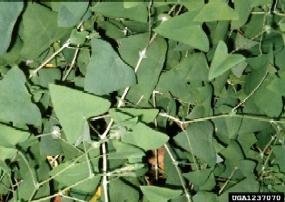 |
| By Britt Slattery, USFWS | | Mile-a-minute (Polygonum perfoliatum) |
 |
Scientific name: Polygonum perfoliatum
Kingdom: Plantae - Plants
Division: Magnoliophyta – Flowering plants
Class: Magnoliopsida - Dicotyledons
Family:Polygonaceae
Genus: Polygonum
Life Cycle: Annual
Description:
Mile-a-minute is an exotic annual vine that can grow up to 14 or 15 feet in height. Its leaves are green and triangular shaped. The stem has downward facing barbs, that are also present on the undersides of the leaves. Flowers are self-pollinating. The fruits average around pea size. They are blue in color which, in turn, make them very attractive to birds, and other wildlife. The plant has been known to grow over 5 inches in a day.
Habitat:
Mile-a-minute has a wide range of suitable habitats. Its four known locations in the park are Shop Run, Hull School Trail, Sams Ridge, and Hog Wallow overlook. It is suspected to be present elsewhere in the park. It thrives in moist soils that are rich in nutrient and exposed to plenty of sunlight. It has been found on roadsides, moist thickets, clearings and ditches.
Common names:
Common names include Mile-a-minute, Asiatic Tearthumb, Ishimikawa, Minuteweed, and Devils Tail.
Other Facts:
Mile-a-minute is known to out compete natives for resources. The plant grows very fast, and will absorb nutrients quicker than its competitors. It will cover the native plants from available sunlight, which doesn’t allow them to photosynthesize. This in turn puts stress on the sun-loving natives and eventually kills them.
There are a couple strategies taken by the National Park Service to prevent further growth. The most effective is to pull the plants by hand. This has been attempted at all known sites in the park. This is effective but very time consuming.
Weed AsideTM Weed Killer has been sprayed on the more overgrown sites in the park. It is a herbicidal soap solution, which selectively kills weeds, including mile-a-minute (Gurneys, 2005). An effort is made to control mile-a-minute in the spring so the it doesn’t have the chance to produce seeds.
References and Links:
Mountain, W.L. 1989. Mile-a-minute update – distribution, biology and control suggestions in Regulatory Horticulture 15(2)21 – 24.
Gurney’s Seed and Nursery - Weed AsideTM Weed Killer
Virginia Department of Conservation and Recreation (VA DCR). nd. Invasive Alien Plant Species of Virginia: Mile-a-minute. Virginia Department of Conservation and Recreation, Richmond, Virginia.
National Park Service (NPS). nd. Plant Invaders of Mid-Atlantic Natural Areas: Mile-a-minute. National Park Service.
Further information can be found:
Integrated Taxonomic Information System (ITIS) Report U.S. Department of Agriculture.
Germplasm Resource Information Network database which is sponsored by the Agricultural Research Service, U.S. Department of Agriculture.
PLANTS National Database, a website supported by the Natural Resource Conservation Service.
| 





